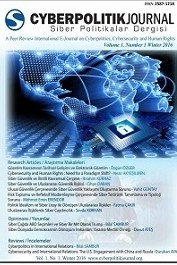CYBERCONFLICTS: AN EFFECT OF GLOBALIZATION ON CONFLICT ECOSYSTEM
CYBERCONFLICTS: AN EFFECT OF GLOBALIZATION ON CONFLICT ECOSYSTEM
___
- Arı, T. (2013). Uluslararası İlişkiler Teorileri: Çatışma,Hegemonya, İşbirliği (8. Baskı ed.). Bursa: MKM Yayıncılık.
- Bousquet, A. (2008, September). Chaoplexic Warfare or the Future of Military Organization. International Affairs (Royal Institute of International Affairs), 84(5), 915-929.
- Choucri, N. (2012). Cyberpolitics in International Relations. Cambridge: MIT Press.
- Delpech, T. (2012). Space and Cyberdeterrence. In T. Delpech, Nuclear Deterrence in the 21st Century (pp. 140-157). New York: RAND Corporation.
- Derian, J. D. (2000, October). Virtuous War / Virtual Theory. International Affairs (Royal Institute of International Affairs), 76(4), 771-788.
- Friedman, G., & Friedman, M. (2015). Savaşın Geleceği:21.Yüzyılda Güç, Teknoloji ve Amerikan Dünya Egemenliği (The Future of War). İstanbul: Pegasus Yayıncılık.
- Friedman, P. W. (2014). Cybersecurity and Cyberwar:What Everyone Needs to Know. New York: Oxford University Press.
- Fukuyama, F. (1992). The End of History and the Last Man. New York: Free Press.
- Galtung, J. (1971). A Structural Theory of Imperialism. Journal of Peace Research, 8(2), 81- 117.
- Galtung, J. (1973). Theories of Conflict: Definitions, Dimensions, Negations, Formations. Hawaii: University of Hawaii Press.
- Galtung, J. (2007). Introduction: peace by peaceful conflict transformation – the TRANSCEND approach. In C. Webel, & J. Galtung, Handbook ofPeace and Conflict Studies (pp. 14-32). New York: Routledge.
- Gamero-Garrido, A. (2014). Cyber Conflicts in International Relations:Frameworks and Case Studies. Boston: MIT and Harvard University.
- Gregory, D. (2011, September). The Everywhere War. The Geographical Journals , 177(3),238-250.
- Held, D., & McGrew, A. (2003). Küresel Dönüşümler:Büyük Küreselleşme Tartışması (The Global Transformations Reader). Ankara: Phoenix Yayınevi.
- Hughes, R. (2010, March). A Treaty for Cyberspace. International Affairs (Royal Institute of International Affairs), 86(2), 523-541.
- Huntington, S. (1996). The Clash of Civilizations and the Remaking of World Order. New York: Simon and Schuster.
- Jackson, R. (2015). Towards critical peace research: lessons from critical terrorism studies. In I. Tellidis, & H. Toros, Researching Terrorism, Peace and Conflict Studies:Interaction,synthesis, and opposition (pp. 19-37). New York: Routledge.
- Kellner, D. (2002, November). Theorizing Globalization. Sociological Theory, 20(3), 285-305.
- Kosenkov, A. (2016). Cyber Confllicts as a New Global Threat. Future Internet, 8(45), 1-9.
- Kriesberg, L. (2012). Mediation in Conflict Systems. Systems Research and Behavioral Science, 29, 149-162.
- Leonhardt, M. (2001). Conflict Analysis for Project Planning and Management: A Practical Guideline Draft. Berlin: Deutsche Gesellschaft für Technische Zusammenarbeit (GTZ) GmbH.
- Lewis, J. A. (2013). Conflict and Negotiation in Cyberspace. Washington: CSIS (Center for Strategic and International Studies).
- Libicki, M. C. (2012). Crisis and Escalation in Cyberspace. New York: RAND Corporation.
- Paul, C., Porche, I. R., & Axelband, E. (2014). Confirming the Analogy: How Alike Are Prfe-U.S. Speciial Operations Command Forces and Contemporary Cyber Forces. In C. Paul,
- I. R. Porche, & E. Axelband, The Other Quiet Professionals (pp. 31-46). New York: RAND Corporation.
- Podins, K., J., S., & M., M. (2013). 5th Conference on Cyber Conflicts:Proceedings. Tallin: NATO CCDCOE.
- Schmitt, M. (2012). Classification of Cyberconflict. Journal of Conflict and Security Law, 17(2), 245-260.
- Swanström, N. L., & Weissmann, M. S. (2005). Conflict, Conflict Prevention and Conflict Management and beyond:a conceptual exploration. Uppsala: Central Asia-Caucasus Institute and Silk Road Studies Program.
- The Editors of Encyclopædia Britannica. (2017, December 6). Ecosystem. Retrieved from Encyclopædia Britannica: https://www.britannica.com/science/ecosystem
- Tierney, N. (2006). Religion, the Globalization of War, and Restorative Justice. Buddhist-Christian Studies, 26, 79-87.
- Wallensteen, P. (2007). Understanding Conflict Resolution:War, Peace and the Global System. London: SAGE Publications.
- ISSN: 2587-1218
- Başlangıç: 2017
- Yayıncı: Cyberpolitik Journal
SİBER UZAY VE GÜVENLİK POLİTİKASI ÜZERİNE TEORİK BİR YAKLAŞIM
KRİPTO PARA: BİTCOİN VE ULUSLARARASI İLİŞKİLER
ULUSAL SİBER GÜVENLİK STRATEJİ BELGELERİNDE İNSAN HAKLARI
‘GÜVENLİKLEŞTİRME’Yİ YENİDEN GÖZDEN GEÇİRMEK: TEORİ VE VAKALAR
SİBER UZAYDA AKTÖR - GÜÇ İLİŞKİSİ
CYBERSECURITY IN EDUCATIONAL SETTINGS
KÜRESELLEŞME SÜRECİNDE DÖNÜŞEN GÜVENLİK ALGISI VE SİBER GÜVENLİK
